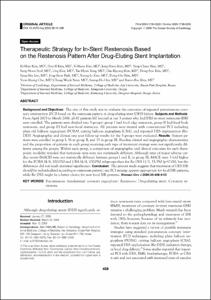KUMEL Repository
1. Journal Papers (연구논문)
1. School of Medicine (의과대학)
Dept. of Internal Medicine (내과학)
Therapeutic Strategy for In-Stent Restenosis Based on the Restenosis Pattern After Drug-Eluting Stent Implantation
- Keimyung Author(s)
- Cho, Yun Kyeong; Nam, Chang Wook; Hur, Seung Ho; Kim, Kwon Bae
- Department
- Dept. of Internal Medicine (내과학)
- Journal Title
- Korean Circulation Journal
- Issued Date
- 2009
- Volume
- 39
- Issue
- 10
- Keyword
- Percutaneous transluminal coronary angioplasty; Restenosis; Drug-eluting stent; Coronary restenosis
- Abstract
- Background and Objectives: The aim of this study was to evaluate the outcomes of repeated percutaneous coronary intervention (PCI) based on the restenosis pattern in drug-eluting stent (DES) failure. Subjects and Methods: From April 2003 to March 2006, all 67 patients (67 lesions) at our 3 centers who had DES in-stent restenosis (ISR) were enrolled. The patients were divided into 3 groups: group I had focal edge restenosis, group II had focal body restenosis, and group III had non-focal restenosis. All patients were treated with conventional PCI including plain old balloon angioplasty (POBA), cutting balloon angioplasty (CBA), and repeated DES implantation (Re-DES). Angiographic and clinical one year follow-up results for the 3 groups were evaluated. Results: Sixteen patients were enrolled in group I, 36 in group II, and 15 in group III. Baseline clinical and angiographic characteristics and the proportion of patients in each group receiving each type of treatment strategy were not significantly different among the groups. Within each group, a comparison of angiographic and clinical outcomes for each therapeutic modality revealed that restenosis rates were not statistically different. Although rates of major adverse cardiac events (MACE) were not statistically different between groups I and II, in group III, MACE were 3-fold higher for the POBA (4/4, 100.0%) and CBA (4/4, 100.0%) subgroups than for Re-DES (1/3, 33.3%) (p=0.06), but the differences did not reach statistical significance. Conclusion: The present study suggests that treatment of DES ISR should be individualized according to restenosis pattern: any PCI strategy appears appropriate for focal ISR patterns, while Re-DES might be a better choice for non-focal ISR patterns.
- Publisher
- School of Medicine
- Citation
- Ki-Hun Kim et al. (2009). Therapeutic Strategy for In-Stent Restenosis Based on the Restenosis Pattern After Drug-Eluting Stent Implantation. Korean Circulation Journal, 39(10), 408–413. doi: 10.4070/kcj.2009.39.10.408
- Type
- Article
- ISSN
- 1738-5520
- Appears in Collections:
- 1. School of Medicine (의과대학) > Dept. of Internal Medicine (내과학)
- 파일 목록
-
-
Download
 oak-aaa-03308.pdf
기타 데이터 / 310.82 kB / Adobe PDF
oak-aaa-03308.pdf
기타 데이터 / 310.82 kB / Adobe PDF
-
Items in Repository are protected by copyright, with all rights reserved, unless otherwise indicated.